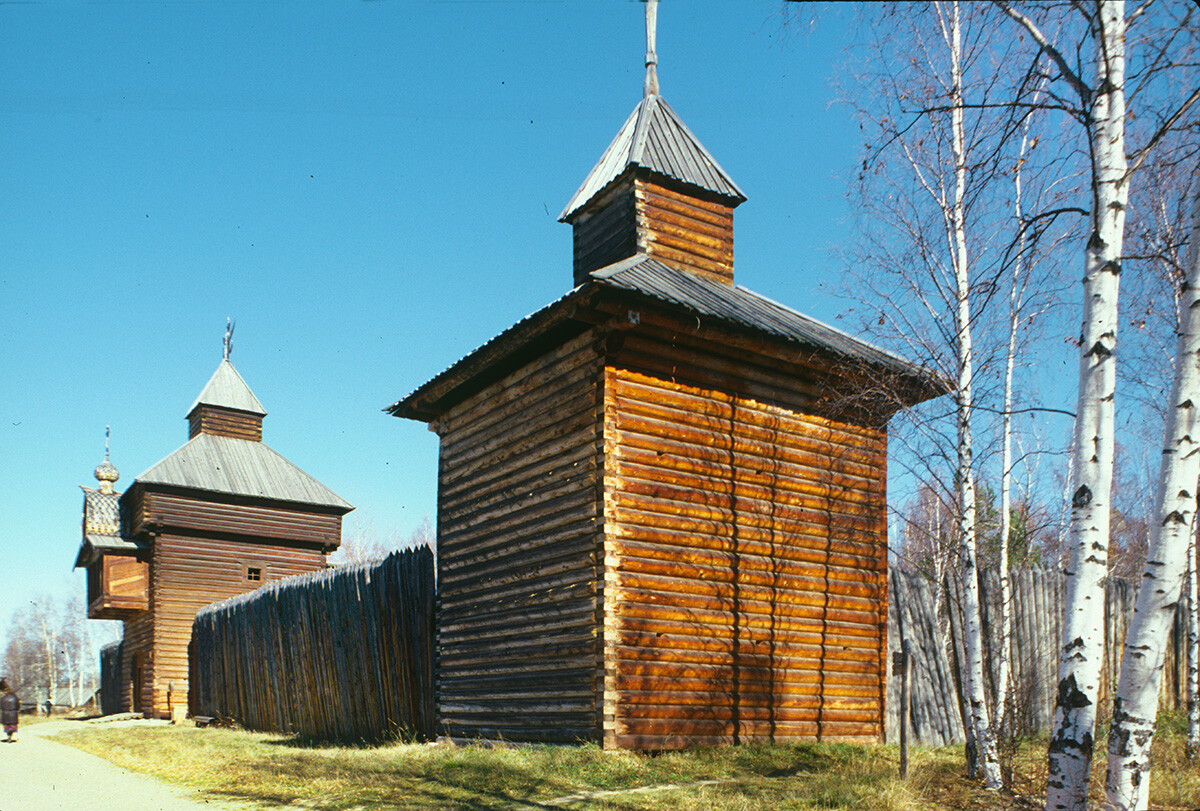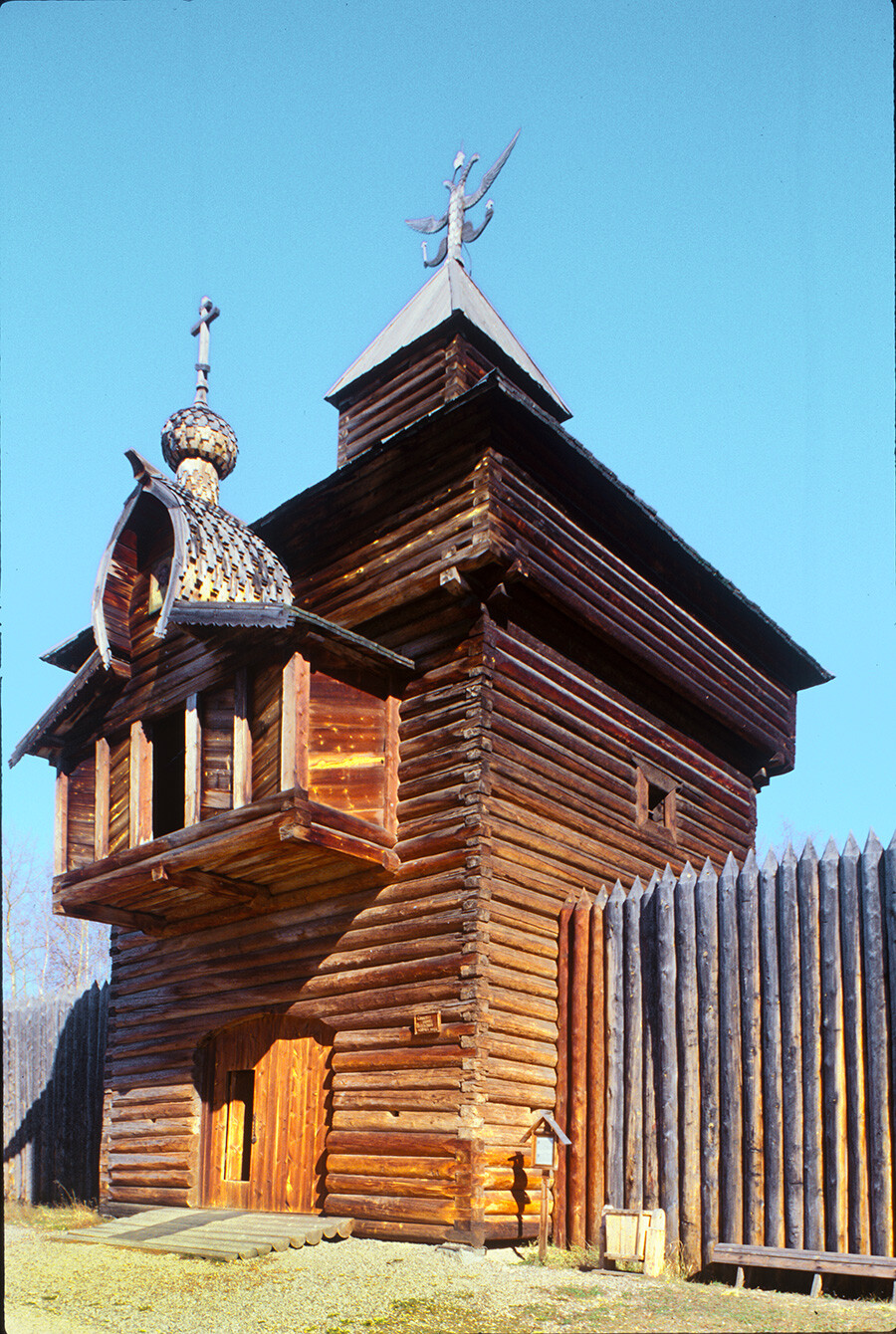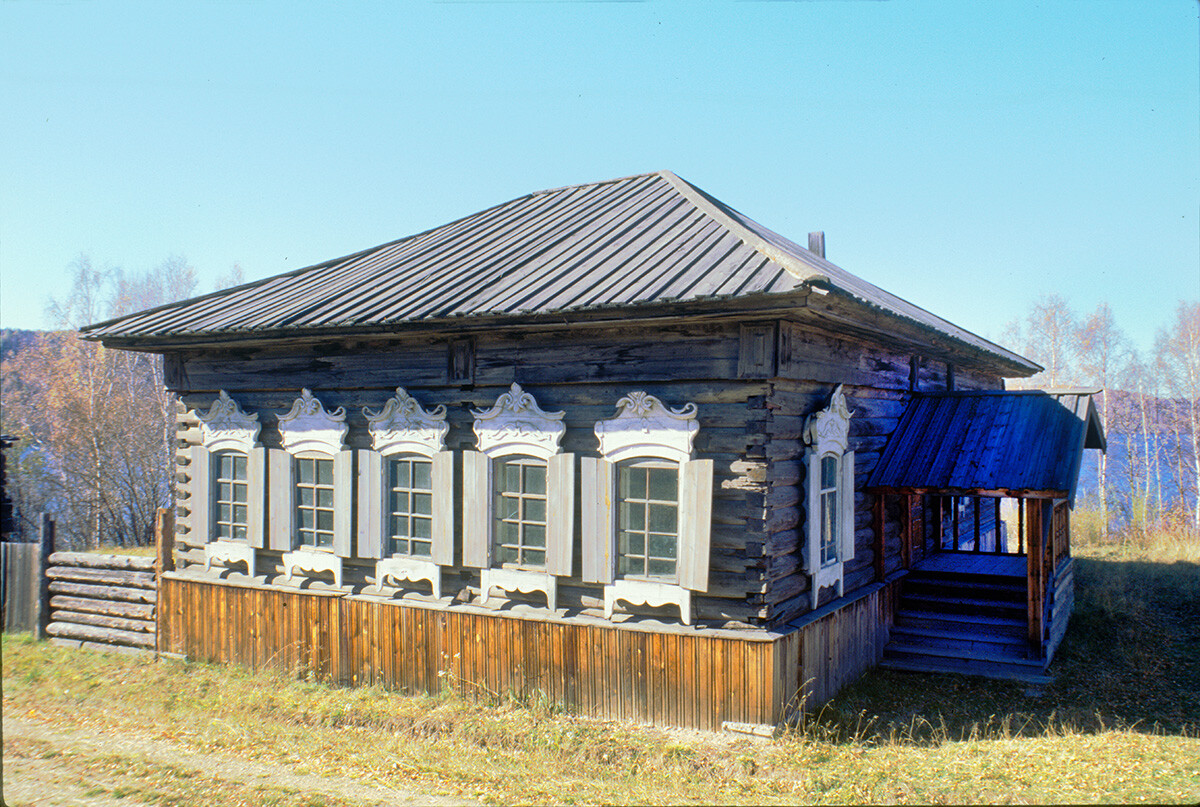Taltsy: Preserving folk architecture in the Lake Baikal area (PHOTOS)

 Taltsy (near Irkutsk). Savior Tower & reconstructed log wall from Ilimsk Fort on Angara River. October 2, 1999
Taltsy (near Irkutsk). Savior Tower & reconstructed log wall from Ilimsk Fort on Angara River. October 2, 1999
At the beginning of the 20th century, Russian chemist and photographer Sergey Prokudin-Gorsky developed a complex process for vivid, detailed color photography (see box text below). Inspired to use this new method to record the diversity of the Russian Empire, he photographed numerous historic sites during the decade before the abdication of Tsar Nicholas II in 1917.
Early applications of the new technique occurred between 1903-1905, when Prokudin-Gorsky made photographic “etudes” in the area surrounding St. Petersburg. A particularly lyrical example is a sunny, snow-covered winter view that he took at the village of Turovo in Luzhsky District (named after the Luga River south of St. Petersburg).
 Turovo village (90 miles south of St. Petersburg). Winter view. 1905
Turovo village (90 miles south of St. Petersburg). Winter view. 1905
Linear across Russia
Although the original glass separation negative for this photograph has not survived, a contact print from the magenta exposure shows a typical line of village houses along a main road. This linear arrangement proved durable throughout Russia, including the distant Baikal Region.
 Taltsy. View of houses & barns in reconstructed village from area along lower Angara River. October 2, 1999
Taltsy. View of houses & barns in reconstructed village from area along lower Angara River. October 2, 1999
Indeed, a similar example can be found in the Taltsy open-air museum of wooden architecture, located at a picturesque, forested site above the Angara River, midway between the Siberian city of Irkutsk and village of Listvyanka, on the southwest shore of sacred Lake Baikal. Taltsy even has a surprising connection with Russian America.
 Taltsy. Savior Tower with reconstructed log wall & corner tower from Ilimsk Fort on Angara River. October 2, 1999
Taltsy. Savior Tower with reconstructed log wall & corner tower from Ilimsk Fort on Angara River. October 2, 1999
Although the origins of the museum at Taltsy date from the early 1960s, a Russian settlement at the site, located near the confluence of the Taltsinka River with the Angara River, can be dated much earlier. In 1758, for example, there is written evidence of a convent in the area.
Baranov & Laxman
In the 1780s, this remote site brought together two major figures in the study and development of Siberia: Alexander Baranov (1746-1819) and Erik (Kirill) Laxman (1737-96), each of whom gained renown as world travelers. Baranov, an entrepreneur and explorer from the northern town of Kargopol, moved his operations to Irkutsk in 1780.
Ten years later, he would become chief administrator of the Northeastern Company, which, in 1799, was reorganized as the Russian-American Company - the company that managed Alaska and Russian America.
Erik Laxman was born in Finland (at that time a part of Sweden) and, at the age of 24, moved to St. Petersburg, where he taught in the city’s Lutheran School. In 1764, he was sent as pastor to a Lutheran parish in distant Barnaul, a major Russian mining settlement on the Ob River near the Altai Mountains.
Some might have seen this as a form of exile, but Laxman was fascinated by the variety and richness of Siberia. Spurred by boundless curiosity and intelligence, he became a major authority on the region in several disciplines. Returning to St. Petersburg in 1769 as an acknowledged scholar, Laxman spent the next decade in expeditions throughout the European part of the Russian Empire, before returning to Siberia in 1781.
Laxman’s legacy
 Taltsy. Savior Tower from Ilimsk Fort, southwest view. October 2, 1999
Taltsy. Savior Tower from Ilimsk Fort, southwest view. October 2, 1999
Drawn in the early 1780s to the cultural and administrative center of Irkutsk, Laxman explored the surrounding area and discovered deposits of sand rich in silica at the Taltsy site. Learning of the discovery, Baranov brought his entrepreneurial skills to Laxman and, together, they formed the Taltsy glass factory, which met an acute need for glass containers throughout the Far East and Alaska.
 Taltsy. Church of Kazan Icon of the Virgin from Ilimsk Fort, southwest view. Background: Savior Tower. October 2, 1999
Taltsy. Church of Kazan Icon of the Virgin from Ilimsk Fort, southwest view. Background: Savior Tower. October 2, 1999
Other enterprises arose at Taltsy, which functioned as a factory settlement, with a small church, throughout the 19th century. Although its significance declined at the beginning of the 20th century, the settlement and glass factory existed until the late 1950s, when the area near the Angara River was submerged with the creation of the Irkutsk Hydroelectric Station. The usable parts of the glass factory were moved to the town of Tulun.
 Taltsy. Parish school from Keul village near Ust-Ilim (lower Angara region). Background: Church of Kazan Icon of the Virgin. October 2, 1999
Taltsy. Parish school from Keul village near Ust-Ilim (lower Angara region). Background: Church of Kazan Icon of the Virgin. October 2, 1999
By virtue of steep cliffs above the Angara, part of the Taltsy site remained above the new reservoir. At the same time, construction of the Ust-Ilim Hydroelectric Station elsewhere on the Angara River threatened one of Siberia’s most important historical monuments, the 17th-century Ilim Fort, with its impressive Savior Gate tower (1667) and portions of the fort walls, as well as the small Church of the Kazan Icon of the Virgin (1679) - all built of pine logs.
 Taltsy. Volost (regional) administrative building from lower Angara region. October 2, 1999
Taltsy. Volost (regional) administrative building from lower Angara region. October 2, 1999
In 1966, the regional administration authorized measures to save the Ilim monuments by creating a museum park near Irkutsk. The Taltsy site was recommended by Galina Oranskaya (1913-86), a Moscow-trained architect and preservation specialist who became the guiding light of historic preservation in Irkutsk. Construction work at the museum site began in 1970, with years spent in finding and reconstructing traditional log structures from the vast Irkutsk territory. The museum opened in 1980.
Taltsy’s composition
 Taltsy. Log posthouse (traktir) from lower Angara region. October 2, 1999
Taltsy. Log posthouse (traktir) from lower Angara region. October 2, 1999
Taltsy consists of four sectors. The largest is the Angara-Ilim sector, whose centerpiece is formed by the 17th-century log structures from the Ilim area. The Ilim fort (ostrog) arose in the Summer of 1630, when 28 cossacks led by ataman Galkin made their way up the Angara to fertile lands at the mouth of the Ilim River. Their winter camp (zimovye) was replaced by a log fort the following year.
 Taltsy. Houses & barns in reconstructed village from lower Angara region. October 2, 1999
Taltsy. Houses & barns in reconstructed village from lower Angara region. October 2, 1999
The early forts succumbed to the fires that plagued Russia’s wooden villages, but portions of a third fort, built in 1667, endured for three centuries. The Ilim fort consisted of a rectangular stockade wall with vertical logs pointed at the top. The wall was anchored by eight pine log towers, including four on the corners. Three of the towers had gates, above which were small projecting chapels. Only the Savior Tower - restored in 1984 - has survived from 1667, but a section of the west wall (with a corner tower) has been reconstructed.
 Taltsy. Log house at farmstead of Cossack named Moskovsky. October 2, 1999
Taltsy. Log house at farmstead of Cossack named Moskovsky. October 2, 1999
The small Church of the Kazan Icon of the Virgin, generally assumed to have been built in 1679, was situated near the Savior Gate and served both as a place of worship and an additional defensive structure. The small structure was frequently modified over the centuries, but the core remained and has been restored in an attempt to replicate the original appearance, although questions remain.
 Taltsy. Log barn at farmstead of Cossack named Moskovsky. Note roof of interlocking concave logs. October 2, 1999
Taltsy. Log barn at farmstead of Cossack named Moskovsky. Note roof of interlocking concave logs. October 2, 1999
The territory near the 17th-century structures is taken by a recreation of villages similar to those that arose around the early forts and then served as administrative centers for the surrounding district (volost). It has a one-room parish school (1885) from Keul village in the Ilim area, as well as a volost administration building, a roadhouse and a communal grain storehouse.
 Taltsy. Log house at Nepomiluev farmstead. October 2, 1999
Taltsy. Log house at Nepomiluev farmstead. October 2, 1999
Of particular interest are the recreations of peasant homesteads, from the late 18th century, the 19th and the turn of the 20th century. The majority of peasants in the Irkutsk territory were of the middle level economically and could afford livestock, an array of agricultural implements and store-bought goods.
 Taltsy. Interior of Nepomiluev log house. Main room with loom in background. October 2, 1999
Taltsy. Interior of Nepomiluev log house. Main room with loom in background. October 2, 1999
One of the museum’s early examples of a homestead comes from Antonova village (Bratsk Region) and was built at the turn of the 19th century by a certain Moskovsky. It is known that he served as a “town Cossack”, who performed police and administrative duties, as opposed to “line Cossack” troops, who guarded the border areas.
 Taltsy. Barn at Nepomiluev farmstead. October 2, 1999
Taltsy. Barn at Nepomiluev farmstead. October 2, 1999
The housing displays include a type of homestead arranged around enclosed courtyards, with one wall of the house facing the street, a gateway and barns and sheds arranged around two or three separate yards, including one where livestock was kept. Such homesteads existed throughout the area when the museum was being formed and still exist in some villages.
Interconnected system
 Taltsy. Buriat log dwelling (yurt) with sod roof (Angara region). October 2, 1999
Taltsy. Buriat log dwelling (yurt) with sod roof (Angara region). October 2, 1999
Some of the dwellings are known as “linked” houses. A family would begin with a single log house and then build a twin structure connected by a passageway as the family grew.
 Taltsy. Buriat log dwelling (yurt) with wooden plank roof. October 2, 1999
Taltsy. Buriat log dwelling (yurt) with wooden plank roof. October 2, 1999
The other large sector at Taltsy displays traditional structures of the indigenous Buryat people, one population of which lives in Irkutsk Territory to the west of Lake Baikal. Before the Russian appearance in the 17th century, the Buryats were herders who frequently moved to favorable grazing lands.
 Taltsy. Interior of Buriat yurt with plank roof. Hearth in center. October 2, 1999
Taltsy. Interior of Buriat yurt with plank roof. Hearth in center. October 2, 1999
In the 18th and 19th centuries, they developed a more settled existence, but continued to build wooden yurts, often covered with turf roofs. The museum has a display of log yurts brought from the encampment of Alagui near the village of Buguldeika. The interiors are a single space with posts supporting a roof tilted upward to release smoke from the hearth in the center. The display also has log sheds typical of summer encampments. At the bottom of the park, by the Angara River, is a display of a fishing camp.
 Taltsy. Left: Evenki shaman's wickiup (chum). Right: Evenki hunter's game shed (labaz), elevated to protect game from predators. October 2, 1999
Taltsy. Left: Evenki shaman's wickiup (chum). Right: Evenki hunter's game shed (labaz), elevated to protect game from predators. October 2, 1999
The smallest sectors, beautifully situated in a grove, are devoted to the indigenous Evenk and Tofa peoples, primarily hunters and reindeer herders. Considered the most ancient population to inhabit the area, the Evenks led a nomadic existence, elements of which persisted into the early 20th century. Their camps, usually inhabited by related families, varied according to the seasons.
 Taltsy. Cascade of water mills with connecting wooden water sluice. October 2, 1999
Taltsy. Cascade of water mills with connecting wooden water sluice. October 2, 1999
The Evenk sector includes a choom (wigwam) typical of spring and fall camps. The frame consists of split logs over laid with a mat of larch bark. Other displays include wooden perches for storing game and supplies, as well as stands for processing animal hides. On the steep slope beyond this sector is a cascade of three linked watermills powered by a single stream.
Japanese link
 Taltsy. Church of the Holy Trinity from Dyadino village. October 2, 1999
Taltsy. Church of the Holy Trinity from Dyadino village. October 2, 1999
Other notable museum displays include the Church of the Trinity, built in 1914 in the remote village of Dyadino and moved to the museum park in 1990 to serve as background for a joint Russian-Japanese film entitled ‘Dreams of Russia’ (Sni o Rossii). Released in 1992, the movie was based on a Japanese historical novel by Yasushi Inoue about a group of 17 shipwrecked Japanese, who were rescued by Russians in the Aleutian Islands and spent nine years traveling about Russia in the 1780s and early 1790s, before receiving permission to return to the closed country of Japan.
A key figure in this drama was none other than Erik Laxman, who met the Japanese in Irkutsk, accompanied the survivors to St. Petersburg and eventually arranged an audience for the Japanese captain with Catherine the Great. Although only three of the Japanese returned to their homeland in 1792, the story illustrates the role played in the beginnings of Russo-Japanese relations by Laxman - a Russified Swede with a connection to Taltsy. Today, the Taltsy museum plays a new role in communication among peoples.
In the early 20th century, Russian photographer Sergey Prokudin-Gorsky developed a complex process for color photography. Between 1903 and 1916 he traveled through the Russian Empire and took over 2,000 photographs with the process, which involved three exposures on a glass plate. In August 1918, he left Russia and ultimately resettled in France where he was reunited with a large part of his collection of glass negatives, as well as 13 albums of contact prints. After his death in Paris in 1944, his heirs sold the collection to the Library of Congress. In the early 21st century the Library digitized the Prokudin-Gorsky Collection and made it freely available to the global public. A few Russian websites now have versions of the collection. In 1986 the architectural historian and photographer William Brumfield organized the first exhibit of Prokudin-Gorsky photographs at the Library of Congress. Over a period of work in Russia beginning in 1970, Brumfield has photographed most of the sites visited by Prokudin-Gorsky. This series of articles juxtaposes Prokudin-Gorsky’s views of architectural monuments with photographs taken by Brumfield decades later.

